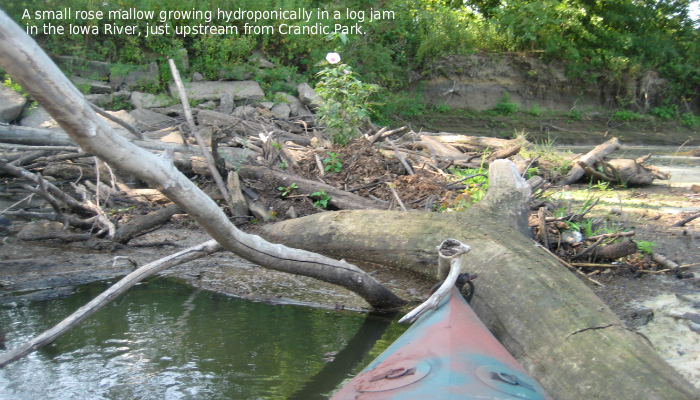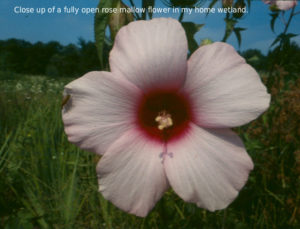Rose Mallow: Our River Flower

The mallow family is quite extensive in the tropics, with fewer species as one proceeds poleward. The domestics probably most familiar to you are cotton, okra, althea, hollyhock, and assorted garden hibiscus. In our part of the upper Midwest, there are two native species, which look similar:
Smooth rose mallow, Hibiscus laevis (aka H. militaris), which has furry seeds.
Swamp rose mallow, Hibiscus moscheutos (aka H. palustris), which has smooth seeds.
Both species have large flat flowers, often 5-6 inches in diameter, with white to soft pink petals, and a deep red or reddish purple throat. Both bloom in late summer, and as you might guess from the multiple names, the taxonomy is still a little messy.
Rose mallows grow in wetlands, and they are especially well-adapted to riverbanks. While the aboveground plant grows herbaceous hollow canes, the belowground systems on older plants are massive clusters of thick roots, which keep them well-anchored during floods. In winter, ice floes grinding along the shore will sometimes leave the plants dangling by only a few roots, sometimes even hanging upside down from a riverbank, but if the soils are wet, they will sprout curving upward canes in spring and bloom in the late summer anyway.
Even if completely torn loose by ice, or eroded out by spring floods collapsing the bank, the root mass will float downstream. And if caught in a logjam, they can get anchored in the debris, and will sprout and flower, – natural hydroponics, see photo.
The thick hollow stems completely die in winter but are still important for wetland rose mallows. In spring, when water levels usually increase, these tubes convey oxygen down to the submerged roots to tide them over until they can grow new shoots and leaves above water line and restart photosynthesis. For this reason, rose mallows only flourish on the edges of ponds and in the higher portions of wetlands.
 Here in the cornbelt, rose mallows are becoming less common along our streams every decade. Our briskly eroding watersheds are cutting their channels deeper, while the enclosing floodplains rise higher with deposited sediment, leaving the streambank a vertical cliff, which is too dry too often in summer to support rose mallow.
Here in the cornbelt, rose mallows are becoming less common along our streams every decade. Our briskly eroding watersheds are cutting their channels deeper, while the enclosing floodplains rise higher with deposited sediment, leaving the streambank a vertical cliff, which is too dry too often in summer to support rose mallow.
They are a pretty rain garden plant, can tolerate its roots submerged often, but will need to be watered it if it doesn’t rain regularly. Easy to grow, needs full sun, try it.


